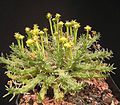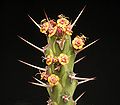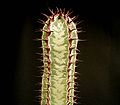Euphorbia
| {{{name}}} LATINNAME
|
'
| ||||||||||||||||||||||||||||||||||||||||
|---|---|---|---|---|---|---|---|---|---|---|---|---|---|---|---|---|---|---|---|---|---|---|---|---|---|---|---|---|---|---|---|---|---|---|---|---|---|---|---|---|---|

|
|
| |||||||||||||||||||||||||||||||||||||||
| |||||||||||||||||||||||||||||||||||||||||
| Standard Cyclopedia of Horticulture |
|---|
|
Euphorbia (classical name; said by Pliny to be in honor of King Juba's physician; possibly from the Greek for fat). Eupharbiaceae. Milkweed (improperly) Wolfs-milk. Spurge. The last name, most often applied to the genus as a whole, belongs more properly to the common herbaceous species and especially to E. Lathyris. Of very diverse habit, from succulent cactus- like trees to low or prostrate herbaceous weeds; planted mostly in the open, but some kinds grown under glass as oddities and some as florist's plants. The genus is characterized by the single pedicellate, pistilate fl. without floral envelopes, or with only a rudimentary calyx, surrounded by numerous staminate fls., each consisting of a single stamen separated from its pedicel only by a joint; the whole infl. surrounded by a more or less cup-shaped involucre with 5 lobes and 1-5 glands is called a cyathium. The involucre is regular or nearly so; the glands free from one another: the fr. an explosive caps., with 3 carunculate seeds; the staminate fls. are usually subtended by minute bracts. — One of the largest plant genera, of not less than 700 and probably over 1,000 species, occurring in most temperate and tropical regions. Many are desert plants and the greater number grow in dry and sterile places. Euphorbia is distinguished from the nearest related genera, Pedilanthus and Synadenium, by its regular or nearly regular involucre, which in Pedilanthus is protuberant on one side of the base and contains the glands, and by the free involucral glands which in Synadenium are united into a ring. Some of the fleshy species are very similar to succulent cacti and Asclepiadaceae. One long grown under the name of E. pendula, Boiss., is a Sarcostemma according to N. E. Brown. For E. tithymaloides. see Pedilanthus; for E. Grantii, Hort.. and E. arborea, Hort., see Synadenium. Monographed by Boissier in DeCandolle's Prodromus, 15, pt. 2 (1862). See local floras and Norton, Kept. Mo. Bot. Card. 11, for native species. Sec also Fobe, in Monatsschrift fur Kakteenkunde, 8:42 (1898) and Berger, Sukkulente Euphorbien, a manual of the cactus-like species in cultivation. The recent work of N. E. Brown of Kew in Flora of Tropical Africa and Flora Capensis describes and gives keys to practically all the African species, which include nearly all the succulent ones, both wild and cultivated. Although the vegetative form varies remarkably, so that the various sections of the genus are considered of generic rank by many authors, the floral characters are very similar and so inconspicuous as to be of little importance generally in a horticultural work. Most of the species have abundant milky juice, and the cactiform kinds have been thus distinguished from cacti, but many cacti also have milky juice. The juice of many species is acrid-poisonous, especially if it comes in contact with mucous membranes or open sores. The juice from some of the species is used in medicine as a purgative. Many of the fleshy species are cultivated by lovers of succulents for their curious shapes; and a few are valuable for their ornamental foliage. The flowers are usually too minute to be noticeable. Some, like E. corollata (Fig. 1437), E. maculata, E. Cyparissias and E. marginata, are weeds in America, but not troublesome. The great majority of the species are insignificant herbs. The species are remarkably free from injurious insects, and are rarely attacked by a few fungi. The fleshy species are grown much the same as cacti, but the culture is less difficult, and they do well with warmer treatment. In winter they are kept in a dry and cool house, 50° to 55° F., with good light and little water. Drips must be carefully avoided. In summer the pots should be plunged outdoors in hot dry situations, with a moderate supply of water and especially good drainage. It is better to protect them from continued rain, but most species do well without this. The more fleshy species, like E. Caput- Medusae, E. mammillaris, and E. meloformis, require more heat and better care than the others. They have to be watered with great care in winter. The air of most greenhouses is too damp for them if the requisite low temperature is maintained. The winter conditions of air and temperature in ordinary living - rooms make them ideal for the succulent euphorbias. Species like E. neriifolia need water in the growing season and dry Conditions after the flower is at leaves fall. The shrubby species, like E. atropurpurea and E. dendroides, do well with the treatment of the more fleshy kinds. See D. A. W. and F. S. Curtis, in Sharon Cactus Guide, March and May, 1897. The few hardy species of ornamental value make good border plants or are suitable for the rockery. E. epithymoides usually known in gardens as E. polychroma, is one of the best herbaceous perennials, forming a hemispherical clump with beautiful yellow foliage of different shades when in bloom. E. palustris and related species are similar but erect and not compact. The succulent species can nearly all be propagated by cuttings. These are taken best in early summer, allowed to dry somewhat and then planted in sand, charcoal or a mixture of these. Coal-ashes are used effectively by some. When seeds can be procured, they may be used in propagation. Grafting, as is sometimes practised with cacti, is possible. Potting soil need not be rich. A coarse sandy loam, or, some say, any kind of soil will do. E. pulcherrima and E. fulgens are good winter-flowering greenhouse plants, and require special treatment. E. fulgens succeeds well in the warmest parts of the house, in pots, or best planted out like roses and trained upon the wall or strings. It is propagated from cuttings taken in June, when the old plants have started to grow, kept in a warm frame until rooted, and then kept growing with heat, any transfers being made with as little root disturbance as possible. If stocky show plants are wanted, several cuttings may be planted in one pot and checked two or three times during summer by repotting, and kept pinched back freely to secure branches. They are best kept cooler when in flower, but are very sensitive to cold or sudden changes in temperature. After flowering they are kept dry for a few months. For the cut sprays they are best grown from cuttings each year. They last very well when cut. The culture of the poinsettia is very similar. To secure plants with large heads, the general plan is to grow from cuttings annually, but the old plants may be continued. Old plants that have been resting may be introduced to heat and moisture in late spring, and will soon give a liberal supply of cuttings, which are usually taken from the young wood. Successive sets of cuttings may be made at later periods if different- sized plants are wanted. When well started, the potted plants are plunged outdoors till September, with plenty of water, light and sunshine and good drainage. They do well in rich heavy loam in 5-7-inch pots. They are liable to drop their leaves if exposed to cold or other unfavorable conditions, lii autumn they are transferred to the greenhouse, with moderate temperature. When the bracts begin to appear, give more heat and some manure water to expand them. When in flower, reduce the temperature to preserve them longer. After flowering the pots may be stowed away in a dry warm place till spring,—under the benches will do. When the buds are cut the great objection is that they wilt easily. This may be obviated by keeping them in water for a few days before using. See Grieve, G.C. III. 9:106, and Hatfield in Garden and Forest 9:496. See article Poinsettia for further treatment. Euphorbia splendens is another winter bloomer, and may be treated as the succulents, with more heat and water. It will do well in living-rooms, and bears some flowers all the year. It bears rough treatment well, and is propagated by cuttings from the young growth, which root with the greatest ease. In tropical and subtropical regions many of the treelike or succulent euphorbias make fine outdoor ornamentals. The poinsettia is a magnificent landscape ornament in California, West Indies and so on. In Southern California the poinsettia is propagated by sticking canes 3 feet long in the ground from April on, these growing and blooming, often profusely, the first season. In the West Indies and Florida, some of the thorny tree-like forms, especially E. lactea, are grown as hedges, their thick, erect thorny branches making an almost impenetrable barrier. This and other species are grown also as specimen plants. See Succulents. CH
|
Cultivation
- Do you have cultivation info on this plant? Edit this section!
Propagation
- Do you have propagation info on this plant? Edit this section!
Pests and diseases
- Do you have pest and disease info on this plant? Edit this section!
Varieties
Subgenerawp:
Chamaesyce
Esula
Euphorbia
Rhizanthium
synonymswp:
Chamaesyce
Elaeophorbia
Endadenium
Monadenium
Synadenium
Pedilanthus
See List of Euphorbia species for complete list.
Selected species wp:
- Euphorbia albomarginata – Rattlesnake Weed, White-margined Sandmat
- Euphorbia amygdaloides – Wood Spurge
- Euphorbia antisyphilitica – Candelilla
- Euphorbia bulbispina
- Euphorbia cyparissias – Cypress Spurge
- Euphorbia decidua
- Euphorbia elastica – (Mexican) Palo Amarillo
- Euphorbia esula – Leafy Spurge
- Euphorbia franckiana
- Euphorbia helioscopia – Sun Spurge
- Euphorbia heterophylla – Painted Euphorbia, Desert Poinsettia, (Mexican) Fireplant, Paint Leaf, Kaliko
- Euphorbia labatii
- Euphorbia lactea – Mottled Spurge, Frilled Fan, Elkhorn
- Euphorbia lathyris – Caper Spurge, Paper Spurge, Gopher Spurge, Gopher Plant, Mole Plant
- Euphorbia maculata – Spotted Spurge, Prostrate Spurge
- Euphorbia maritae
- Euphorbia milii – Crown-of-thorns, Christ Plant
- Euphorbia myrsinites – Myrtle Spurge, Creeping Spurge, donkey tail
- Euphorbia peplis – Purple Spurge
- Euphorbia peplus – Petty Spurge
- Euphorbia pulcherrima – Poinsettia, Mexican Flame Leaf, Christmas Star, Winter Rose, Noche Buena, Lalupatae, Pascua
- Euphorbia resinifera – Resin Spurge
- Euphorbia serrata – Serrated spurge, Sawtooth spurge
- Euphorbia tirucalli – Indian Tree Spurge, Milk Bush, Pencil Tree
- Euphorbia tithymaloides – Devil's Backbone, "Redbird cactus", cimora misha (Peru)
- Euphorbia virosa
| Standard Cyclopedia of Horticulture |
|---|
|
{{{1}}} The above text is from the Standard Cyclopedia of Horticulture. It may be out of date, but still contains valuable and interesting information which can be incorporated into the remainder of the article. Click on "Collapse" in the header to hide this text. |
Gallery
- Esula
- Light green flowers.jpg
Wood Spurge
Euphorbia amygdaloides Cypress Spurge
Euphorbia cyparissiasLeafy Spurge
Euphorbia esulaMyrtle Spurge
Euphorbia myrsinites
- Rhizanthium
- Chamaesyce
Painted Euphorbia
Euphorbia heterophyllaPoinsettia
Euphorbia pulcherrima
- Euphorbia
References
- Standard Cyclopedia of Horticulture, by L. H. Bailey, MacMillan Co., 1963
External links
- w:Euphorbia. Some of the material on this page may be from Wikipedia, under the Creative Commons license.
- Euphorbia QR Code (Size 50, 100, 200, 500)













